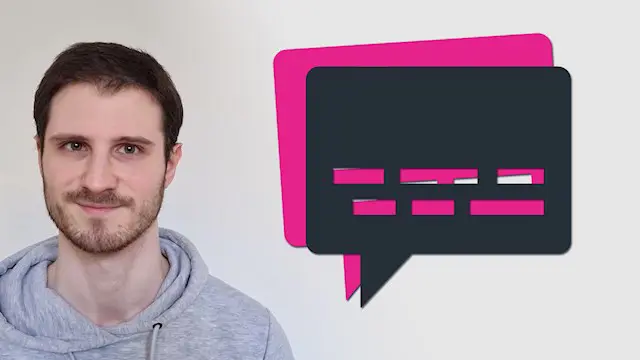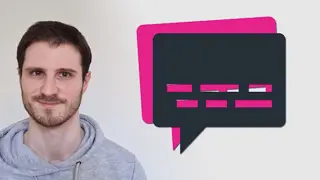
Caption This! Become a Pro in Video Captioning and Subtitles
Felix Tuna
All you need to know to create, edit and translate captions for your videos - including examples and recommendations.
Add to basket or enquire
Overview
Certificates
Reed courses certificate of completion
Digital certificate - Included
Will be downloadable when all lectures have been completed
Curriculum
-
Introduction: What It's All About 17:25
-
Theory: About Subtitles and Closed Captions 21:01
-
Guidelines: Nice and Clean Captions 14:41
-
Preparation: Transcribe Your Video 13:08
-
The Offline Way: Manually Prepare Captions With Desktop Tools 27:09
-
The Subtitle Track: Integrate Captions into Your Video File 20:56
-
The Online Way: Caption Videos Manually and Automatically Online 12:39
-
Translation: Appeal to Your International Audience 11:53
-
The End: What Did You Learn? 04:33
Course media
Description
You may know the closed caption icon from YouTube or Netflix. Captions are an important tool in video production to make videos and even entire movies or TV shows accessible to a larger - possibly even international - audience. Deaf and hearing impaired people can easily follow and understand your videos through subtitles. You help foreign language learners to learn a new language. Maybe you have even used subtitles in your favorite TV show yourself to improve your foreign language skills - especially if English is not your first language.
In this course I will teach you a lot about subtitles and captions. You will not only learn how to create and edit subtitles with free offline and online editors, but also some theoretical background on formats, guidelines to create great captions, transcriptions and even translations. This video course contains nine sections:
-
Introduction
In this section I present the course contents and give you a quick introduction to captions. -
Theory
This section gives you some nice to have background knowledge on the difference between subtitles, closed captions and open captions as well as an overview on the most important subtitle formats. If you are already at an intermediate or expert level, you may skip this sections. Beginner, however, should definitely take a look at those videos. -
Guidelines
This is one of the most important sections. Many courses and videos teach about how to create captions. However, a lot of them fail to explain how to design great captions that are easy to follow and that do not distract from the video content. Captions should support the viewer in his understanding of your video contents. While well designed captions add value to a video, bad captions may even disturb the viewer. I explain some of the most important guidelines to you and even show you a short example of good and bad captions. Please to not skip this section, even if you want to start creating captions right away! -
Preparation
This section deals with transcriptions. Do you think you can create captions directly without a script? Maybe that will work. But maybe it won't. A transcription of the video can help you later on. Keep in mind that this is not an in-depth course about transcriptions. I just want to introduce you to the topic of transcriptions and show you some tricks, software and hardware to use. -
The Offline Way
This section is the one you were all waiting for. In this section I teach you how to use offline tools like Subtitle Edit or Aegisub to create captions for your videos. To benefit the most, I advise you to also download these tools and try them out yourself. Create some captions for your own videos to train your captioning skills! -
The Subtitle Track
After you have created your own captions in the last section, this section shows you how to use subtitles offline. I will explain how to embed subtitles into MP4 and MKV video files as a track and how to use captions with the VLC media player. This section is relevant for you, if you want to work with videos and captions offline. If you want to create subtitles for your online videos, take a look at the next section, instead. -
The Online Way
This section presents different websites and online editors to create, edit and upload closed captions to your videos. I will explain why different formats are important and show you ways to use captions for your YouTube videos and Udemy courses. You need this section for any online videos, because websites cannot read the subtitle tracks you may have created in the sixth section. -
Translation
Through captions you can appeal to an international audience and grow your community over time. This section presents processes and tools for an easy and cheap translation of your videos. -
The End
In this last video I recap what you have learned in the course. Congratulations on coming this far!
Who is this course for?
This course is for:
- Video producers who want to appeal to an even greater audience.
- YouTubers and video course creators who want to create and use captions for their videos.
- (Explanatory/learning) video creators who want to translate their videos for their international audience.
- Transcribers who want to learn a new skill similar to their current profession.
Requirements
To try out your newly learned skills, you need a video file to create captions for. If you do not have a video file ready, you can either record your own short test video (e.g. using your smartphone) or download a video you want to use from the internet, e.g. YouTube.
Furthermore, some very fundamental computer skills (e.g. how to download and use software) are required.
Career path
Here are two career paths you can take a look into:
- Transcriber (in general)
- Captioner (more specifically).
You can look for freelancer portals, work for TV or movie productions, video games or any other kind of video production. A more specific career path is live-captioning (doing captions in real-time).
Questions and answers
Currently there are no Q&As for this course. Be the first to ask a question.
Reviews
Currently there are no reviews for this course. Be the first to leave a review.
Legal information
This course is advertised on Reed.co.uk by the Course Provider, whose terms and conditions apply. Purchases are made directly from the Course Provider, and as such, content and materials are supplied by the Course Provider directly. Reed is acting as agent and not reseller in relation to this course. Reed's only responsibility is to facilitate your payment for the course. It is your responsibility to review and agree to the Course Provider's terms and conditions and satisfy yourself as to the suitability of the course you intend to purchase. Reed will not have any responsibility for the content of the course and/or associated materials.


